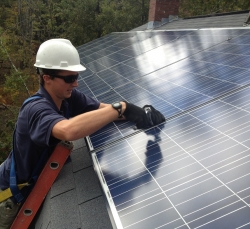New England Solar Cost-Reduction Partnership - Focus Areas
 Below are some of the cost-reduction focus areas where the New England Solar Cost-Reduction Partnership was engaged.
Below are some of the cost-reduction focus areas where the New England Solar Cost-Reduction Partnership was engaged.
Community Solar
Several of the participating states have virtual net metering legislation in place. Virtual net metering allows utility customers to share the electricity output from a single power project, typically in proportion to their ownership of the shared system. This enables people who might not otherwise be able to adopt solar on their own—perhaps because of their status as renters, or because of high upfront costs or unsuitable siting conditions—to participate in a community shared solar project. In this way, community solar expands the solar market. But community solar can also help reduce solar soft costs by leveraging economies of scale. By participating in community solar arrangements, participants can lower certain solar balance-of-system costs (e.g., customer acquisition expenses).
The Partnership took important steps to make community solar more accessible. Massachusetts worked with three of its municipalities on community shared solar-related projects:
- The City of Boston conducted a feasibility study for community shared solar on its public buildings.
- The City of Cambridge pursued a solar guide for condominium associations. This guide presented information on how Massachusetts condominium associations or members of condominium associations can go solar. One of the topics the guide will address is potential community shared solar arrangements for condominium associations.
- The Town of Winchester conducted a feasibility analysis for a prospective community shared solar project to be sited on a building owned by a local, non-profit organization.
CESA worked with stakeholders in Vermont to petition the Internal Revenue Service for additional guidance on the circumstances in which community shared solar participants are eligible for the federal residential solar tax credit (IRC § 25D). (Read more)
Financing
Participating states explored solar-friendly financing arrangements to encourage solar deployment by reducing the financial barrier of up-front installation costs. Such programs can provide favorable terms for homeowners to spread out the PV systems’ costs over time.
Through Rooftop Solar Challenge I, Connecticut made substantial progress in developing innovative financing programs, including the Connecticut Solar Loan, the Connecticut Solar Lease II, and a commercial Property Assessed Clean Energy (PACE) program. Connecticut and Rhode Island both explored residential PACE financing to their states. Massachusetts developed a residential solar loan program to provide homeowners with lower credit scores access to cash-flow positive loans. Vermont explored creating credit enhancements for developers and electricity off-takers to encourage lenders to provide debt for community shared solar projects in the state. CESA produced a guide for homeowners on solar leases, loans and power purchase agreements - read it here.
Interconnection
Each state regulates the process by which a solar electricity generator can connect to a distribution grid by establishing interconnection standards. Many states have established special grid interconnection requirements for PV systems that have been approved by state public utility commissions.
Through Rooftop Solar Challenge II, participating states worked with their utilities to streamline interconnection standards for small-scale residential PV systems. Each participating state worked with its utilities to identify specific steps the utilities can take to improve interconnection processes.
Vermont has an expedited solar registration and interconnection approval process for PV systems sized 15 kW or less. Under Vermont’s process, the authority to issue permits for PV installations is centralized through the Vermont Public Service Board. After submittal of a small-scale PV registration application, the local utility has ten days to object to the permit issuance. If the utility does not object, a permit, known as a Certificate of Public Good, is automatically deemed issued to the applicant on the eleventh day. Other participating states learned about Vermont’s small-scale solar registration and interconnection approval process.
Permitting and E-Permitting
Municipalities in Connecticut, Massachusetts, New Hampshire, and Rhode Island are responsible for providing permitting requirements for new solar system installations. While many residential solar systems share similar design characteristics, local permitting requirements vary and can be unnecessarily complex, costly, and slow. Some of our participating states produced permitting guides or other advisory support to local jurisdictions to help them simplify and streamline their residential solar permitting requirements. For example, under Rooftop Solar Challenge I, Massachusetts released a Recommended Model Permitting Processes document. Connecticut recently released a Connecticut Rooftop Solar PV Permitting Guide and conducted outreach to its municipalities to encourage municipal adoption. New Hampshire and Rhode Island both compiled information about their states’ municipal permitting practices and created model permitting guides of their own.
Another way to streamline PV permitting processes is through online permitting, or e-permitting. E-permitting can speed up transaction times and limit bureaucratic redundancies. Rhode Island is moving toward e-permitting for all of its municipalities. The Rhode Island Department of Administration released an e-permitting Request for Proposals in February of 2014 and selected a vendor to implement e-permitting state-wide. Over a dozen municipalities in Connecticut are using ViewPermit, an enterprise-level customized permitting platform, for their entire municipal e-permitting needs. SimplyCivic, a Rooftop Solar Challenge II partner, developed an online permitting software system available to Connecticut municipalities to pilot for free through 2014. Several Connecticut municipalities explored using SimplyCivic for e-permitting. Several Massachusetts municipalities received SimplyCivic demonstrations as well.
Structural Review
Many municipal building departments in New England require a Professional Engineer to review and provide stamped drawings for solar PV applications before issuing permits for them. Such structural reviews can be costly and time consuming. In some cases, these reviews are necessary. But, for some residential solar applications when specific structural criteria are satisfied, it may be possible to streamline the process by waiving the full Professional Engineer review requirement without compromising structural reliability or system safety.
Several participating states took steps to make structural review guidance available to municipalities for small residential applications to limit the instances where a full Professional Engineer review is required. Under Rooftop Solar Challenge I, Massachusetts consulted with an engineering firm to create a prescriptive process for a structural approval of small PV systems when certain structural criteria are met. With consultation from another engineering firm, Connecticut released its own structural review worksheet to evaluate the integrity of a roof’s framing for a proposed PV system. New Hampshire explored generating a PV structural review guidance of its own as well.
Solarize
Solarize is a PV group purchasing program that aims to lower acquisition costs for residential PV installations by combining four components:
- Discount, Tiered Pricing: Pre-negotiated group buying discounts increase as more people sign up within a target community (i.e., the more people who go solar under a Solarize campaign, the lower the price for everyone who participates in the community).
- Community-Driven Outreach: These methods may include social media campaigns, town meetings, and booths at community events.
- Competitively-Selected Installers: Through a competitive bidding process, the targeted community selects an installer or installers to service the area throughout the duration of the Solarize campaign. This reduces installers’ customer acquisition and screening costs and saves the consumer from the effort of shopping around for a reputable, price-competitive installer.
- Limited Time Offer: Solarize campaigns are limited time offers. This motivates customers to act quickly, or risk missing the window of opportunity to install solar PV at a reduced rate.
Solarize cost savings result from coordinated education, promotion, and outreach effort provided by town volunteers, along with discounted, tiered pricing which takes advantage of economies of scale. These savings are passed along to homeowners who enroll in the program.
Solarize in Connecticut and Massachusetts has been tremendously successful in increasing the rate of residential PV adoption by expanding the potential customer base, speeding up solar deployment, and driving down installation prices for consumers. CESA published a Solarize Guidebook for state program managers seeking to establish Solarize programs in their states, which served as a resource for New Hampshire and Rhode Island as they explored launching Solarize programs of their own.
Zoning
Generally, municipalities can regulate the installation of PV systems through their zoning authority. Municipalities can support residential PV generation by enacting solar-friendly zoning ordinances or bylaws which do not unreasonably restrict homeowners’ ability to adopt solar.
Massachusetts developed a model solar zoning bylaw and policy guidance. Massachusetts conducted a webinar on its model solar zoning bylaw to introduce the bylaw to the state’s municipalities.

